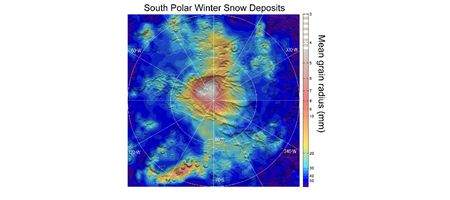NASA’s Mars Reconnaissance Orbiter (MRO) has returned the first definitive evidence of carbon dioxide snowfalls on Mars – the only place this is known to happen anywhere in our solar system.

Frozen carbon dioxide – better known as ‘dry ice’ – requires a temperature of about minus 193 degrees Fahrenheit. The snow was seen falling around Mars’s south pole in winter.
“These are the first definitive detections of carbon dioxide snow clouds,” says Paul Hayne of NASA’s Jet Propulsion Laboratory (JPL). “We firmly establish the clouds are composed of carbon dioxide – flakes of Martian air – and they are thick enough to result in snowfall accumulation at the surface.”
The MRO’s Mars Climate Sounder looked at clouds straight overhead and sideways, recording brightness in nine wavebands of visible and infrared light as a way to examine particles and gases in the Martian atmosphere.
The new analysis is based on data from the south polar region during the southern Mars winter in 2006-2007. The team identified a tall carbon dioxide cloud about 300 miles across over the pole, as well as smaller, shorter-lived, lower-altitude carbon dioxide ice clouds at latitudes from 70 to 80 degrees south.
“One line of evidence for snow is that the carbon dioxide ice particles in the clouds are large enough to fall to the ground during the lifespan of the clouds,” says David Kass of JPL.
“Another comes from observations when the instrument is pointed toward the horizon, instead of down at the surface. The infrared spectra signature of the clouds viewed from this angle is clearly carbon dioxide ice particles and they extend to the surface. By observing this way, the Mars Climate Sounder is able to distinguish the particles in the atmosphere from the dry ice on the surface.”
Mars’ south polar residual ice cap is the only place on Mars where frozen carbon dioxide lies on the surface all year round. It’s not known just how it gets deposited in the first place: whether it occurs as snow or by freezing out at ground level as frost.
These new data shows snowfall is especially heavy on top of the residual cap.
“The finding of snowfall could mean that the type of deposition – snow or frost – is somehow linked to the year-to-year preservation of the residual cap,” says Hayne.






